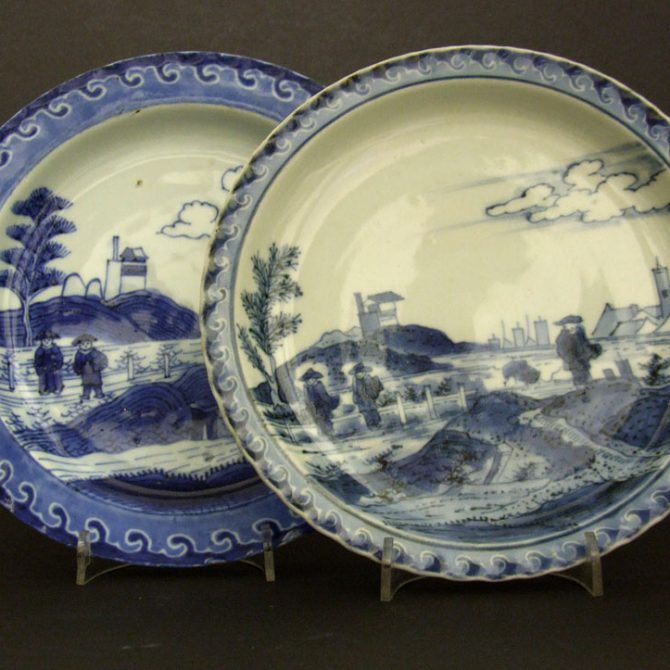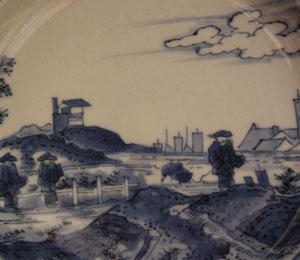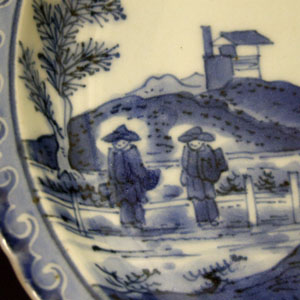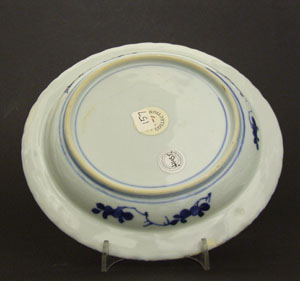
JAPANESE, ARITA c.1700 – 1740 and CHINESE,YONGZHENG PERIOD 1723 – 1735.
Two Blue and White 18th Century Porcelain Plates Painted with the So-Called Deshima Island Pattern. One Japanese, Arita Kilns c.1700-1740 the other Chinese Export Porcelain, Yongzheng Period 1723 – 1735. These Plates are Decorated in The Style of The Dutch Delft Pottery Decorator Frederik Van Frytom (1632 – 1702). The Scene Used to be thought of as Deshima Island However it is now Thought to be a View of Holland.Plates and Dishes of this Pattern were Recovered from the Ca Mau Shipwreck. See Stock 14792 and also History.
SOLD
- Condition
- The Japanese Arita dish is Perfect. The Chinese dish has a large rim chip that goes through to the front, this has been painted over but the filling is visible from the back c.10 x 6mm, it is possible it is larger on the front but because of the over painting it is difficult to known. It also has a long body crack.
- Size
- Diameter, Chinese : 20 cm (7 3/4 inches) Diameter, Japanese : 19 cm (7 1/2 inches)
- Provenance
- The Tom Lurie Collection of Chinese Export Porcelain, label on the Japanese dish number 282 and on the Chinese dish 157.
- Stock number
- 22495
- References
- For a Japanese porcelain version of this dish see : Ko-Imari Porcelain From The Collection Of Oliver Impey (Barry Davies Oriental Art Ltd, London, 1997) pages 136-137, item 75. For Chinese porcelain examples see : Tau Co Ca Mau, The Ca Mau Shipwreck 1723 - 1735 ( Nguyen Dinh Chien, Na Noi, 2002 ) Plates 27 - 30. Made in Imperial China, 76,000 Pieces of Chinese Export Porcelain from the Ca Mau Shipwreck, Circa 1725. Sotheby`s Amsterdam, 29,30 & 31 January 2007, lots 223 to 233.
Information
Frederik Van Frytom :
The Dutch artist Frederik Van Frytom (1632 - 1702) was an important painter of Delft pottery, his style of painting fits very well within the 17th century Dutch landscape tradition, it includes typically Dutch scenes, rustic landscapes with small bridges, pollarded willow and cows scattered about small fields. His ceramic painting technique was individual, more akin to painting than merely filling in a design on a ceramic body. Van Frytom`s connection with oriental ceramics stems from a series of small blue and white Delftware dishes painted by him that were made for the Tea-Ceremony in Japan, the bases of which were marked MB and dated 1684 (See Frederik Van Frytom 1632 - 1702, Life And Work Of A Dutch Pottery-Decorator, A.Vecht, Scheltema and Holkema NV, Amsterdam, 1968). The best known of Van Frytom`s designs is the so-called Deshima Island pattern, now known to be a view of Holland. Porcelain plates of this pattern, as well as related designs, were produced at the Arita Kilns in Japan and then in China at the Jingdezhen kilns, related designs also occurs on Chinese soft-paste porcelain. Plates and dishes of the so-called Deshima Island pattern dating to the Yongzheng period (1723-1735) were sold at Sotheby`s Amsterdam Sale of Chinese Porcelain from the Ca Mau Cargo, "Made in Imperial China". This Western style was then re-used, probably via Japanese or Chinese interpretations, in England at The Bow Factory using soft-paste porcelain, at least some of these Bow pieces closely relate to Chinese soft-paste porcelain versions of the design. However, the Chinese soft-paste examples are quite late in date, so it might well be possible that they are based on the Bow examples that are copying the Japanese or Chinese versions of the Delft. A complex and somewhat confusing inter-connection of design and trade.



